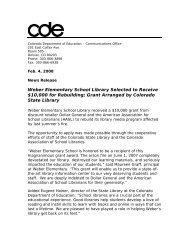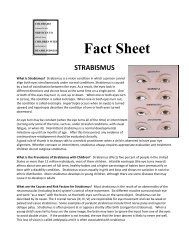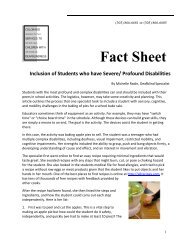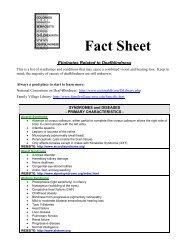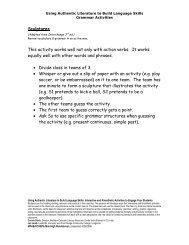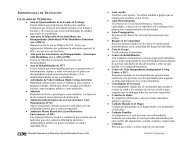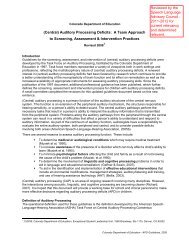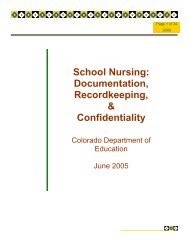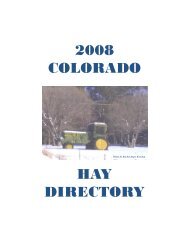ONLINE EDUCATION INTERIM REPORT - Colorado Department of ...
ONLINE EDUCATION INTERIM REPORT - Colorado Department of ...
ONLINE EDUCATION INTERIM REPORT - Colorado Department of ...
Create successful ePaper yourself
Turn your PDF publications into a flip-book with our unique Google optimized e-Paper software.
6<br />
INTRODUCTION<br />
This interim report <strong>of</strong> the <strong>Colorado</strong> State Board<br />
<strong>of</strong> Education Online Education Task Force (task<br />
force) examines key issues related to online<br />
education. Task force members agree that 1)<br />
online education has become a viable element<br />
<strong>of</strong> <strong>Colorado</strong>’s public education system, 2) the<br />
role <strong>of</strong> technology in educating our children will<br />
continue to grow, and 3) online education has<br />
signifi cant potential to help students succeed.<br />
The challenge facing our state is the need to<br />
develop online programs, schools, policies, and<br />
procedures that will enable these options to<br />
realize their potential for successful outcomes.<br />
The state, school districts, and school leaders<br />
must determine how to fi t online education into<br />
existing structures, and decide when and how<br />
to adjust our education systems to help online<br />
education fulfi ll its promise.<br />
A recent statewide performance audit <strong>of</strong> 12<br />
online schools that focused its fi ndings and<br />
recommendations on one online school, the<br />
Hope Online Learning Academy Co-Op (Hope),<br />
has heightened attention to online education.<br />
The report discusses various aspects <strong>of</strong> the<br />
current system in need <strong>of</strong> improvement and<br />
addresses central elements that the audit<br />
examined. The task force found shortcomings<br />
in the audit report. The audit staff themselves<br />
noted the limitations <strong>of</strong> their effort during the<br />
audit report hearing, and it is noteworthy that<br />
the legislative audit committee did not take any<br />
action in response to the report.<br />
This task force report is not organized around<br />
the audit’s fi ndings and recommendations and<br />
it does not have the same emphasis. Because<br />
Hope’s delivery mechanism, which has existed<br />
for only two years, has several characteristics that<br />
make it unique among the state’s full-time online<br />
schools, the task force cautions policymakers<br />
to avoid making decisions about the entire<br />
online education system based solely on Hope’s<br />
experience.<br />
According to <strong>of</strong>fi cials with Hope and recent<br />
media coverage, the assertion that many Hope<br />
students entered the school far behind grade<br />
level appears to be true. Further analysis is<br />
clearly necessary. It is possible that the rapid<br />
growth <strong>of</strong> Hope’s enrollment, combined with<br />
low initial performance levels <strong>of</strong> its incoming<br />
students, produces low average CSAP scores<br />
that misrepresent the learning that takes place<br />
in these settings once they enroll. Audit fi ndings<br />
and recommendations and the <strong>Colorado</strong><br />
<strong>Department</strong> <strong>of</strong> Education’s responses can be<br />
found in Appendix A.<br />
Full-time online education in <strong>Colorado</strong> is the<br />
primary focus <strong>of</strong> this report. Supplementary<br />
online education – students accessing online<br />
education while simultaneously enrolled in a<br />
physical school - is also briefl y discussed. While<br />
a thorough examination <strong>of</strong> supplemental online<br />
education’s policy implications is needed, it is<br />
not included in the report because this issue<br />
was not addressed in the state audit. The task<br />
force recommends that a review <strong>of</strong> supplemental<br />
online education includes a complete analysis<br />
<strong>of</strong> resources, costs, funding, academic and<br />
remediation benefi ts, student demographics, and<br />
capacity potential.<br />
The report is organized in the following sections:<br />
1. Defi nitions<br />
2. Background<br />
3. Benefi ts and Challenges<br />
4. Accountability<br />
5. Access<br />
6. Funding<br />
7. Recommendations<br />
Our fi ndings and recommendations are discussed<br />
in the sections on accountability, access, and<br />
funding and are also summarized on pages 22-23.




